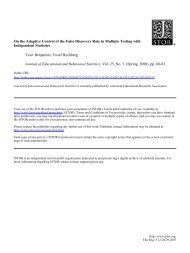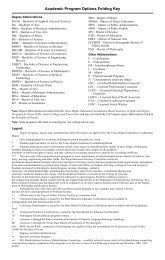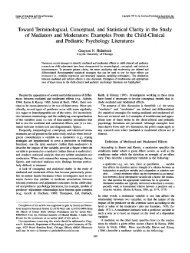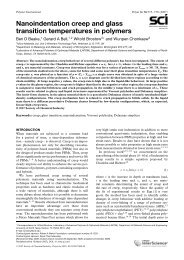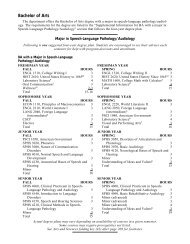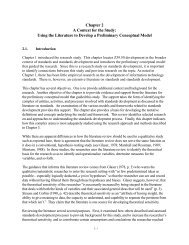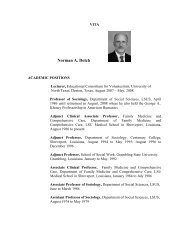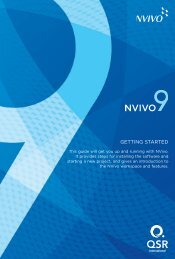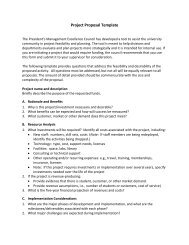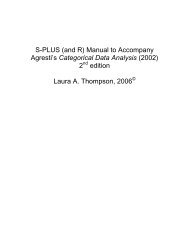APPENDIX C-4 Record Content Analysis Methodology
APPENDIX C-4 Record Content Analysis Methodology
APPENDIX C-4 Record Content Analysis Methodology
Create successful ePaper yourself
Turn your PDF publications into a flip-book with our unique Google optimized e-Paper software.
Moen & McClure An Evaluation of U.S. GILS Implementation June 30, 19975.2.1. Issues in Developing <strong>Record</strong> <strong>Content</strong> Aggregation CriteriaThe following definitions served as an initial starting point for operationalizing the phenomenon of aggregation:AGGREGATION: the degree to which two or more separate parts have been brought together withoutchanging their function or producing any result other than the sum of the operation of the parts.GRANULATION: the degree to which two or more separate parts of a whole are distinguishable within thatwhole.It became apparent during review of the Phase 1 sample that the above definitions are unsuitable for application toGILS records. For example, a record describing a publicly-accessible enterprise-wide AIS whose function is to trackinformation output of four discrete, functionally dedicated, not publicly accessible micro-AISs could be labeled a“highly aggregated” record in that it “rolls up” other potential records. But, should the record include a descriptionof each “grain” (microsystem) it embraces, one would be tempted to code it “low granularity” (subparts aredistinguishable).Another, more concrete, example of the problem of characterizing aggregation of information resources would beThe Federal Register in digital (databased) or paper print format. This one record describes one “discrete”publication, but that publication aggregates myriad standalone information objects that, in print, are highly granularto the initiated user but in database form (digital format) are less distinguishable.Another, more concrete, example of the problem of characterizing aggregation of information resources would beThe Federal Register in digital (databased) or paper print format. This one record describes one “discrete”publication, but that publication aggregates myriad standalone information objects that, in print, are highly granularto the initiated user but in database form (digital format) are less distinguishable.In short, the attribute of “aggregation” is discernible only to the degree that the GILS record presents an explicitenumeration of “granules” or aggregated parts—whether those parts are:• book chapters,• database fields,• Web page titles, or• Privacy Act records,which some will argue is too granular, or they are:• individual reporting systems of enterprise-wide AIS,• titles within a videotape series, or• memoranda within a “file,”which some will argue should be distinguishable.Application of definitions of aggregation and granularity imply a knowledge of component-level and collectivefunctionalities that the investigators, and, by proxy, a GILS user, lack and which may be gained only throughexamination of the object. In a physical library, users of a card catalog, subject bibliography, or other metadatabasedtools are accustomed to retrieving and scanning resources’ object-peculiar “primary” metadata (e.g., tables ofcontent, graphics, and back-of-the-book indexes) as required to determine whether “granules” might satisfy theirinformation need; in GILS, where often information resources cannot be examined and thus their “operation” isunknown, the concept of simply “pointing” to an aggregated “locator” may be insufficient in that the aggregation“produces no result other than the sum of the operation of the parts.”Nonetheless, because record and resource aggregation was identified as a recurring theme during other datacollection activities of the study, investigator’s adopted the operational definitions of aggregation coding schemeshown in Table C4-3 Aggregation Semantics to characterize the phenomenon. To supplement the limited valuereturned from assigning aggregation-level coding, investigators incorporated the criterion of “information object” asdefined in Table C4-4 as well. Appendix E-2 <strong>Record</strong> <strong>Content</strong> <strong>Analysis</strong> Findings, Discussion, and Recommendationsoffers additional interpretation of the utility of these measures relative to aggregation and resource description.C-4—Page 5



